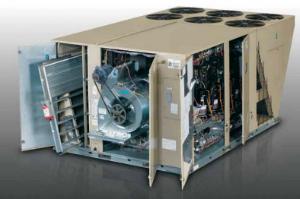 HVAC systems adapt to the different needs of the sector and to the new codes proposed that seek to make equipment more efficient, for that reason the technology does not stop in its development.
by Lennox
HVAC systems adapt to the different needs of the sector and to the new codes proposed that seek to make equipment more efficient, for that reason the technology does not stop in its development.
by Lennox
As standards shape the commercial construction industry, the need to find new ways to save on the energy use of already efficient HVAC systems continues to grow.
Building codes ASHRAE 90.1-2010 and Title 24, in force in several states and provinces in the United States and Canada, require new standards of energy efficiency in commercial construction. These minimum design requirements for energy efficiency apply to new buildings and their systems, to modifications to the cooling systems of existing constructions, and to additions made to existing buildings.
To meet this growing need, original equipment manufacturers (OEMs) are currently offering multistage supply fan technology as a factory-installed option in several lightweight roof models for commercial applications.
Multistage fan technology helps reduce energy consumption, while maintaining comfort requirements. By employing a variable frequency drive or electronic switching motor (ECM), the multistage option offers the function of decreasing airflow during part-load cooling, heating, ventilation and free cooling modes of operation to dramatically reduce energy costs.
This option, preconfigured at the factory, allows you to start up the unit quickly and easily. With great flexibility, this technology allows you to customize airflow settings with just a few small changes to the unit's intelligent controller (Prodigy®). This alternative not only saves money, but also helps users meet the requirements of ASHRAE 90.1-2010 and Title 24 (California) for single-zone variable airflow (VAV) systems.
Here's a brief look at how multistage technology makes it possible to save energy in different operating modes:
Ventilation mode
When a building is occupied and the supply fan is turned on to provide the minimum outdoor air requirements, the speed of the supply fan can be decreased by up to 50% or more. In this way a reduction of approximately 80% or more in the energy consumption of the supply fan could be achieved, when it is operating in this mode.
Part-load cooling mode
Up to four speeds can be configured for the cooling stages, depending on the CFM per ton configuration and the minimum air requirements of the evaporator coil. The factory default setting for the first cooling stage is 67% speed on the fan.
Free cooling mode
By starting the supply fan at part-load cooling speed, during its operation in free cooling mode energy savings are optimized. The supply blower will increase at maximum speed if the cooling needs grow and the desired temperature is not obtained in the established period.
Heating mode
The speed of the supply fan can be decreased during heating, in order to allow additional energy savings in the fan, when the temperature change guidelines in the heat exchanger of the product specifications are followed.
To learn more about how to increase the efficiency of your building's HVAC systems, how to meet sustainability requirements, and how to start saving with multistage technology, visit your OEM's website and search for the various options available.













